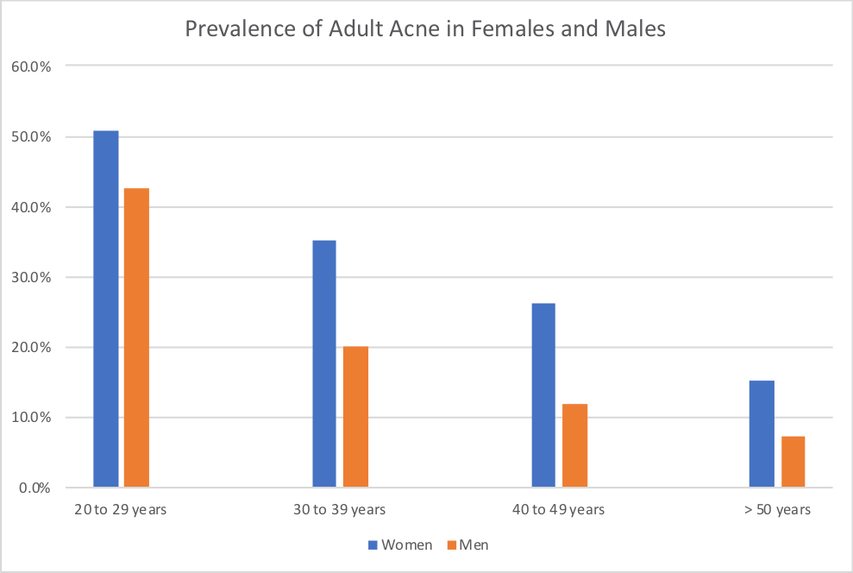Acne statistics – update
Acne is a global skin condition affecting an estimated 9.4% of the population, predominantly impacting adolescents and young adults, though it remains common in adult women. Approximately 50% of women in their 20s, 33% in their 30s, and 25% in their 40s continue to experience acne. In the U.S., acne is the most frequently diagnosed skin condition, with teenage boys more commonly affected than girls. However, female patients represent nearly two-thirds of dermatological visits for acne, most of whom are under 25, with the average age of patients now at 24.
Nearly 85% of people in the U.S. experience acne at some point, affecting about 50 million Americans annually. Of these, around 15% endure severe acne that leads to scarring. Interestingly, the average age of individuals with acne has risen from 20.5 to 26.5 years over the past decade, possibly due to lifestyle and hormonal factors. Acne has been linked to a higher risk of depression, with 11% of those affected reporting severe depression. One study showed that 96% of acne sufferers felt depressed about their condition, 46% experienced self-esteem issues, and 31% avoided social situations.

The Journal of the American Academy of Dermatology published a study indicating that adult acne is more prevalent in women, with rates of 50.9% in those aged 20-29, decreasing to 15.3% in women over 50. Acne affects 99% of people on the face, with 60% also experiencing body acne, particularly on the back and chest. Its primary causes are genetic and hormonal, though diet, makeup, stress, and physical activity can contribute to breakouts.
In the U.S., over $6 billion is spent annually on acne treatments, with only 10% of individuals consulting dermatologists and the majority relying on over-the-counter products.
MDacne offers a distinct advantage over generic acne treatments through its personalized, AI-powered approach that tailors treatments to individual skin needs. By focusing on personalized analysis, MDacne addresses the specific causes of each person’s acne for faster, more sustainable results with fewer side effects. Subscribers benefit from continuous support, customized adjustments, and a combination of FDA-approved medications and plant-based products for maximum effectiveness and minimal irritation. This approach provides a more effective solution for both teens and adults dealing with diverse acne types, promoting healthier, clearer skin with long-lasting results.
Read more:
How to start treating your teen’s Acne
Proven facts about the psychosocial effects of Acne
References:
- Vos T, Flaxman A, Naghavi M, Lozano R, Michaud C, Ezzati M, et al. Years lived with disability (YLDs) for 1160 sequelae of 289 diseases and injuries 1990-2010: a systemic analysis for the Global Burden of Disease Study 2010. Lancet. 2012;380(9859):2163–2196.
- Schäfer T, Nienhaus A, Vieluf D, Berger J, Ring J. Epidemiology of acne in the general population: the risk of smoking. Br J Dermatol. 2001;145(1):100–104.
- Cunliffe W, Gould D. Prevalence of facial acne vulgaris in late adolescence and in adults. BMJ. 1979;1:1109–1110.
- Collier C, Harper J, Cantrell W, Wang W, Foster K, Elewski B. The prevalence of Acne in adults 20 years and older. J Am Acad Dermatol. 2008;58(1):56–69.
- Wilmer E, Gustafson C, Ahn C, Davis S, Feldman S, Huang W. Most common dermatologic conditions encountered by dermatologists and non-dermatologists. Cutis. 2014;94:285–292.
- Davis S, Narahari S, Feldman S, Huang W, Pichardo-Geisinger R, McMichael A. Top dermatologic conditions in patients of color: an analysis of nationally representative data. J Drugs Dermatol. 2012;11(4):466–473.
- Yentzer B, Hick J, Reese E, Uhas A, Feldman S, Balkrishnan R. Acne vulgaris in the United States: descriptive epidemiology. Cutis. 2010;86:94–99.
- McConnell R, Fleischer AJ, Williford P, Feldman S. Most topical tretinoin treatment is for acne vulgaris through the age of 44 years: an analysis of the National Ambulatory Medical Care Survey, 1990–1994. J Am Acad Dermatol. 1998;38:221–226.
To find the right acne treatments for your unique skin, take the free skin assessment by clicking here.




